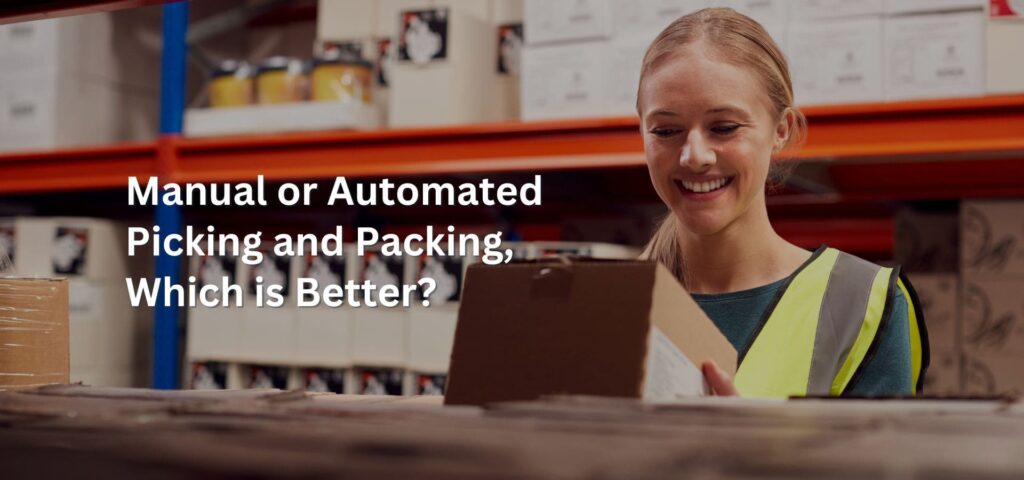Manual or Automated Picking and Packing, Which is Better?

Image by Canva
Manual or Automated Picking and Packing, Which is Better in Inventory Management
Inventory management lies at the heart of a well-functioning supply chain, and one crucial aspect of this process is the picking and packing of goods. In the modern business landscape, companies often face the dilemma of choosing between manual and automated approaches to streamline their inventory management.
While both methods have their unique benefits and challenges, understanding the nuances and implications of each is vital for making an informed decision that aligns with the business’s specific needs and goals.
Manual Picking and Packing
Manual picking and packing, a traditional approach to inventory management, involves human labor and physical handling of products. While this method has been prevalent for decades, it comes with its set of advantages and limitations.
Advantages of Manual Picking and Packing
One significant advantage of manual picking and packing is the flexibility it offers in handling diverse product types and sizes. Additionally, manual processes allow for greater customization and personalization in fulfilling specific customer orders, especially in industries with unique product requirements.
Limitations and Drawbacks of Manual Processes
However, manual picking and packing are often susceptible to human errors, leading to inaccuracies and delays in order fulfillment. Moreover, the dependency on manual labor can result in slower processing times, especially during peak periods, potentially affecting customer satisfaction and overall business performance.
Automated Picking and Packing
On the other hand, automated picking and packing systems leverage advanced technology and robotics to streamline the inventory management process. These systems offer various benefits but also pose certain challenges that companies must consider before implementation.
Efficiency and Speed of Automated Systems
Automated picking and packing systems are known for their high-speed operations and precision, leading to increased productivity and reduced processing times. By minimizing human intervention, these systems can handle large volumes of orders efficiently, contributing to enhanced customer satisfaction and improved operational efficiency.
Potential Challenges and Initial Investment
Despite the advantages, the initial investment in automated systems can be substantial, posing a significant financial barrier for some businesses. Additionally, the complex nature of these systems might require specialized technical expertise, leading to additional training costs and potential maintenance challenges.
Comparison between Manual and Automated Processes
To make an informed decision, businesses need to conduct a thorough comparison of the key differences between manual and automated picking and packing methods, considering various aspects such as cost implications, adaptability, and scalability.
Cost Implications and Return on Investment
While manual processes may initially seem cost-effective, the long-term benefits of automation, such as increased efficiency and reduced error rates, can lead to significant cost savings and improved ROI over time.
Adaptability and Scalability of Each Approach
Manual processes are often more adaptable to changing business requirements and can be easily modified to accommodate variations in product lines and order volumes. In contrast, automated systems may offer limited flexibility but excel in managing high-volume orders consistently.
Impact on Inventory Management
The choice between manual and automated picking and packing directly influences the overall inventory management strategy, including aspects like accuracy, error reduction, and customization.
Accuracy and Error Reduction with Automation
Automated systems are renowned for their precision and accuracy, significantly reducing the likelihood of errors in order fulfillment and inventory tracking. This enhanced accuracy can lead to improved customer satisfaction and better decision-making based on reliable data insights.
Flexibility and Customization with Manual Processes
Manual picking and packing allow for a higher degree of customization and personalization, enabling businesses to cater to specific customer demands and niche market requirements effectively. This flexibility can be particularly beneficial for businesses dealing with unique or specialized products.
Considerations for Implementing Either Method
Before making a definitive choice, businesses must evaluate several factors that can influence the suitability of manual or automated picking and packing systems within their specific operational context.
1. Company Size and Scale of Operations
The scale of operations and the size of the business are critical considerations in determining the most suitable inventory management approach. Smaller businesses may find manual processes more manageable, while larger enterprises might benefit from the scalability and efficiency offered by automated systems.
2. Industry-Specific Requirements and Regulations
Different industries may have specific regulatory requirements and compliance standards that influence the choice between manual and automated picking and packing. It is essential to align the chosen method with industry-specific guidelines to ensure seamless operations and legal compliance.
Combining Manual and Automated Processes
Rather than viewing manual and automated picking and packing as mutually exclusive options, businesses can explore the potential benefits of integrating both approaches to create a hybrid solution tailored to their unique operational requirements.
Integration Challenges and Benefits
The integration of manual and automated processes requires careful planning and seamless coordination to ensure smooth workflow transitions and optimal efficiency. Businesses must invest in robust technology infrastructure and employee training to facilitate the successful integration of both methods.
Enhanced Operational Efficiency and Error Reduction
By combining the strengths of manual and automated processes, businesses can achieve enhanced operational efficiency and improved error reduction, leading to streamlined inventory management and enhanced overall business performance.
Conclusion
The choice between manual and automated picking and packing methods in inventory management is a critical decision that can significantly impact a company’s operational efficiency, cost-effectiveness, and overall business performance. By carefully evaluating the specific requirements and constraints of their business, companies can make an informed decision that aligns with their long-term goals and objectives, ultimately contributing to sustainable growth and success in the dynamic marketplace.
Categories
- Axacute Highlights (2)
- Blog (123)
- Distribution (3)
- Features (5)
- Industry (1)
- Inventory (49)
- Manufacturing (59)
- Production (22)
- Technology (27)
- Warehouse (53)
- Wholesale (1)
Have Questions? Contact Us
Related
4. Quality Control Protocols
Related
Categories
- Axacute Highlights (2)
- Blog (123)
- Distribution (3)
- Features (5)
- Industry (1)
- Inventory (49)
- Manufacturing (59)
- Production (22)
- Technology (27)
- Warehouse (53)
- Wholesale (1)
Try our FREE plan, NO credit card required.
Talk to us. Would you like to learn more about Axacute?
Fill in your details and we will get back to you shortly.






